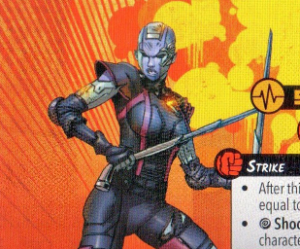
Coming to you in a joint effort of Ulysses, Fingerguns and UtilityCookie, we will try to shine a light on how to play the ultimate badasses of MCP, Black Order. If you like to win by absolutely dominating the opponent and showing them who’s boss, Black Order is the right affiliation for you. Black Order does not care how many points your opponents’ models cost or which models they are. Are you tired of facing Angela and her running away? Are you sick of Enchantress stealing your stuff? Do you just hate M.O.D.O.K? Come join the Order and watch them fall.
Execution of the Game Plan
Now that we know what our roster looks like, it is time to bring Black Order to the tabletop. But you might still be wondering how to translate your awesome roster and your new found knowledge to victories on the tabletop. The crises dictate a lot in what to bring and how to set up. Below we will try to explain general approaches to deployment, the first turn, and later turns.
Deployment and the first turn
Depending on the crises, you want to either deploy central or dedicate hard on one flank (B and C shaped secures), while grabbing the closest extracts with Proxima, a 2-threat, or Thanos. Let’s assume we won priority and chose Skrulls and the opponent brought a D shaped secure, such as Extremis Consoles. A typical list at 17 consists of:
Thanos with the Time and Mind gem
Corvus with the Reality gem
Proxima
Here you will focus on your back secure and one flank, your opponent will often run at least one more model or sometimes 2 more models at 17. This leaves the opportunity for you to pass once or twice, activate Proxima and grab an extract, before showing your opponent where you will end up on the board. This will give your opponent 1-3 opportunities for your opponent to make the common mistake of allowing Thanos to isolate and “Tractor Beam” a model to their doom. This play is hard for your opponent to stop, without ceding a lot of board presence. The centerline is not a safe place against the Black Order. Squads that are accustomed to leaving a model remotely close to mid-board on turn one are in for a surprise.
Turn 1 ”tractor beam play”
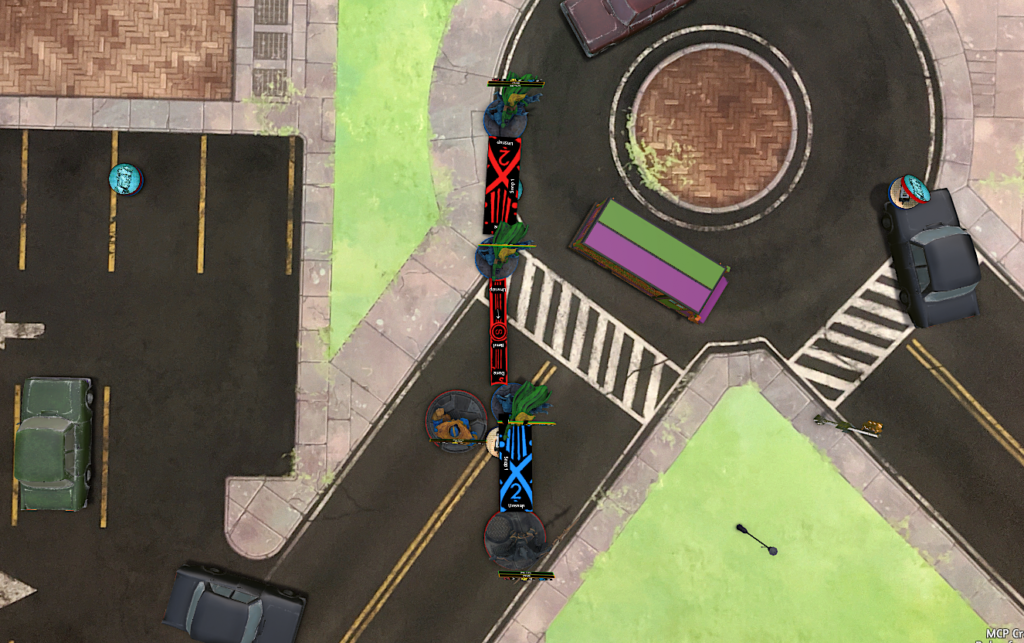
In the above image, you can see your opponent’s mistake of grabbing a central extract early. The “Tractor Beam” play also works in other situations. For example, even a model parked on the front of your opponent’s home gamma shelter is not safe. A single medium move from Thanos will put that model in range 4 and will allow a Cosmic Portal and a Mind Gem move, resulting in the enemy model ending up within range 2 of Corvus in his deployment zone. With the Time Gem, Thanos even has two more actions to take, two strikes will fuel his power supply for later turns, enabling him to hand out Death’s Decrees for days or to Cosmic Portal multiple enemy models. If the above example happens, it probably means that that model is KO’d after the first activation of the second round by Corvus, giving you a VP and the nice extract that they conveniently brought to you.
General tactics
Since Black Order is a small model count list, each activation has to be used to its full potential. A single activation of a powerful model can lead to big payoffs, but each mistake can outright lose you games against a savvy opponent. To help you on your way, we will give some general pointers and review some board states that you will come across when playing Black Order.
Using Thanos
Thanos might be even more important than Corvus in your roster, not that surprising since he makes up a good 7-9 threat of your list. Luckily, he really does feel like he more than makes up for his cost. We already covered the “Tractor Beam” play, which he will often be using on activated models to park them near Corvus. Below are some other examples of how to use him.
Thanos as a Control Piece
Before

After
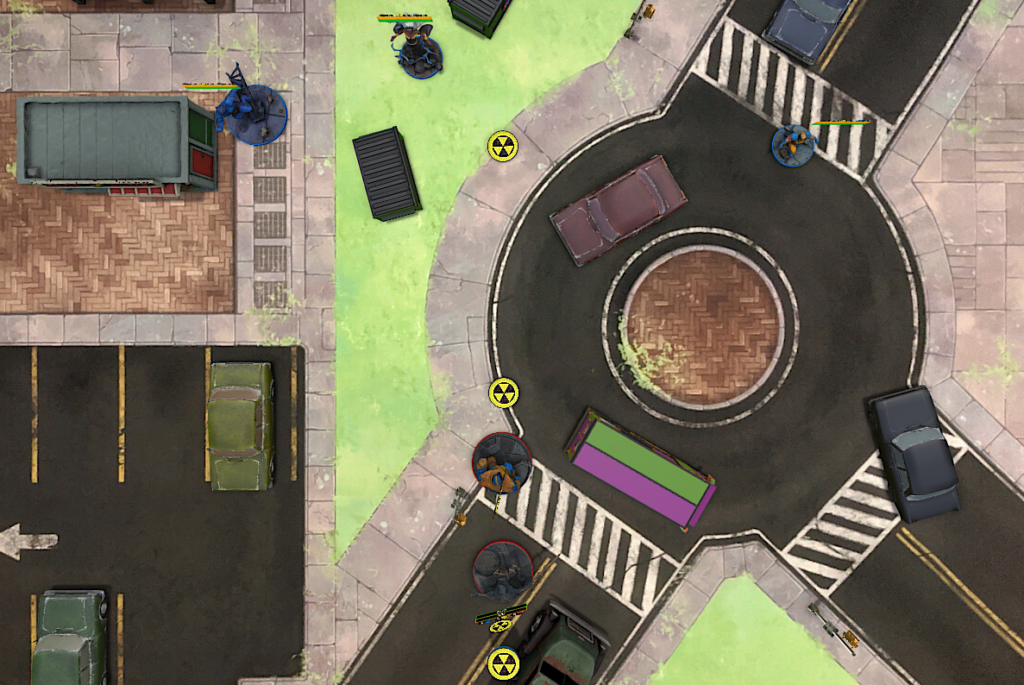
In the above images you can see the board state before and after a Thanos activation.
In this example Thanos did three strikes/energy blasts on both Beast and Wolverine. If you roll a wild you get to push and slow, or throw, depending on the attack. With two gems and the power gained off these strikes, Thanos will often have enough to pay for three portals if it is past round 1.
This can lead to the board state you see in the after example. After both initial displacements from Thanos’s attacks, we Cosmic Portaled Beast a further range 2, used the Mind Gem to advance Wolverine S, then portaled both Storm and Wolverine range 2.. Not only does this deny points if these models are activated, you’re also keeping Thanos safe from retaliation, barring long range attacks, or enemy control abilities. Keep in mind here that the enemy models will still have to walk in range to attack, since they are now more than range 5 away. Brutal!
Thanos’s Serve and Smash
Before

After

A more aggressive approach is the Thanos Serve and Smash. Here we start with the same board state as before, Thanos uses a Cosmic Portal and a Mind Gem advance to pull Storm in and uses another Cosmic Portal to set Wolverine up to be smashed around. A Time Gem bearing Thanos can now strike Wolverine three times, or start wailing on the other models if you happen to roll well. If you roll wilds on any of your strikes, you can throw Wolverine into Beast or Storm for some sweet added damage!
You will have to carefully weigh which version of Thanos you will use each round, but, as you can see, he has a big impact on the table. Both of these are extreme examples (particularly, rolling wilds on the strikes), but you can imagine the effectiveness of using a combination of control, to fully displace one enemy model, and setting up two models to be potentially thrown into each other with three strikes.
A last tip is to make sure to always save at least two power on Thanos if Corvus has not activated yet, in order to give Corvus some extra dice with Death’s Decree.
Mothership Plays
Before
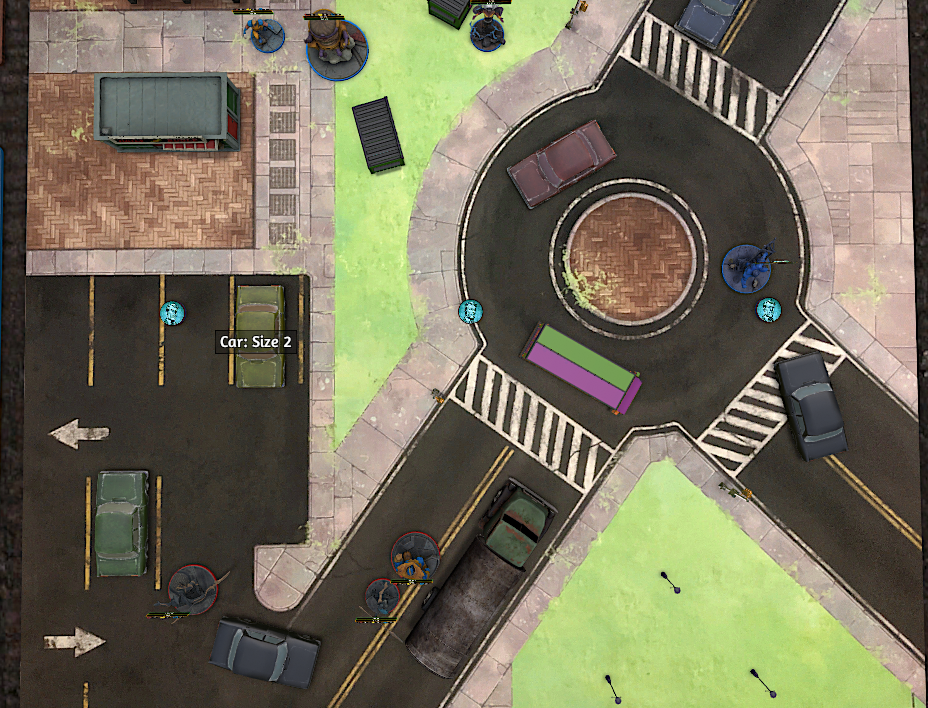
After
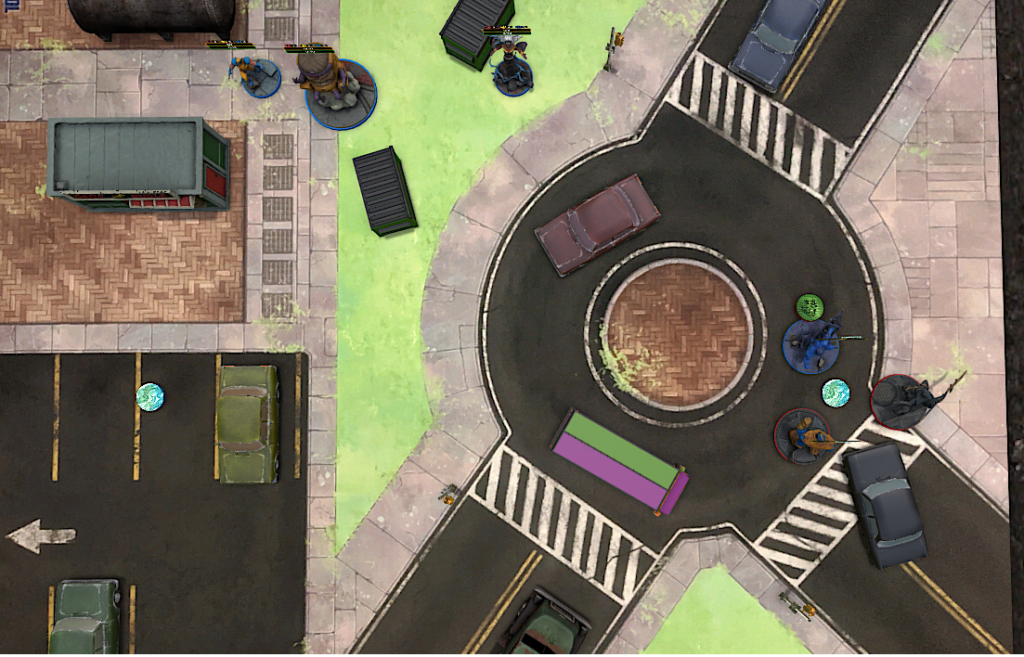
Mothership is another staple card that you will almost always bring in your five. It has several different uses. It can be used as an anti-control card. Maybe Corvus has been displaced a couple of times after he has activated. Just use Mothership and he is back in the fray! A strong use of this card to get Corvus right where you want him is to activate Proxima first, have her get into a good position, use Mothership to put Corvus next to her, and then activate Corvus through using the husband and wife combo. As you can see in the example above, the deployment was skewed to one side of the board. The opponent can’t really risk trying to find the Skrull on the “empty’’ side, because, as you can see, Thanos with the Time Gem (or Proxima if she has 2 power) can just walk over and use Mothership to put Corvus right next to the extract carrier of the opponent.This, again, showcases why Skrulls and Alien Ship are such good extracts for Black Order. Hunting the carrier down is rather easy for them.
Punishing Angela for Grabbing a Skrull or Senator
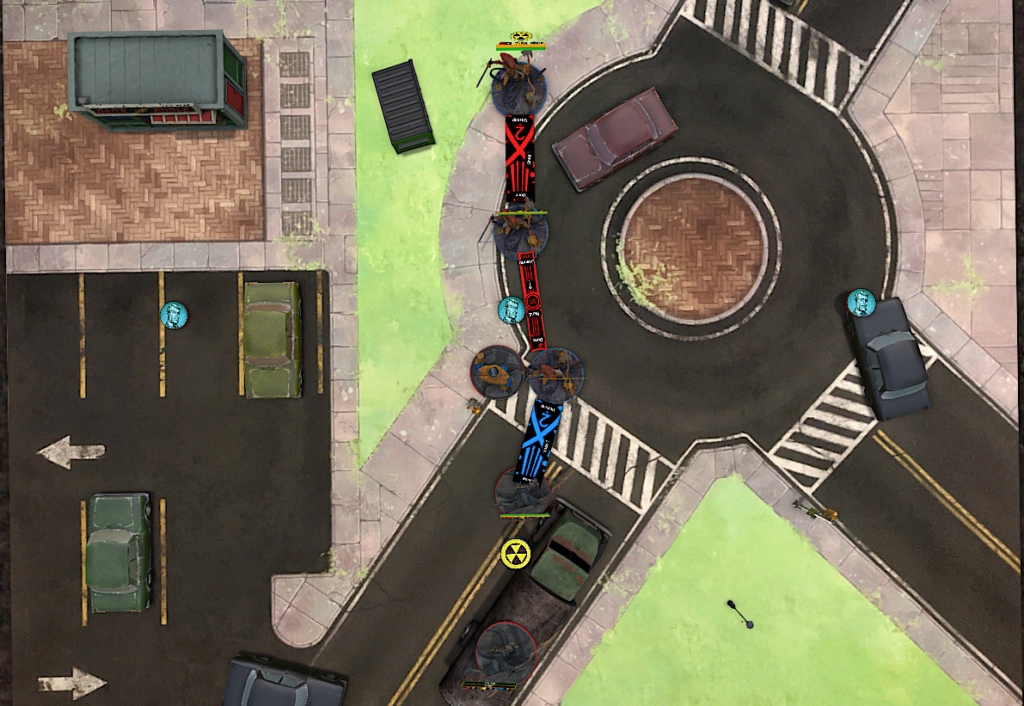
Angela,with her long move and medium sized base is able to make typically safe extract plays on the center line. In the above example you can see where she ends up after picking up a Senator or Skrull. (On Alien Ship, she must stay in the center.) After she has picked up this extract, she only has a short move back, normally enough to keep her safe. As you can see, however, she is still in double move range of Thanos, who can pull her all the way back to the center. This leaves you with a 6 dice strike with a wild throw and a single move away from Corvus’s strike range. Additionally, you can boost Corvus’s strike to seven dice if Thanos dealt one damage to Angela and you are running his Time and Mind version. Creating a position like this will probably mean Angela will never activate again during the game because she is either in a dazed state after Corvus activates or KO’d the round right after. This is one of the main strengths of Black Order; you get to choose which models an opponent will get to play with, because of the sheer certainty that you can place a chosen model next to Corvus and, then, daze or KO that model.
Using Corvus and Proxima
We talked a lot about the KO power of Black Order, but how do they do this, you ask?
It is mainly through two things. First is the ability to control priority with the husband and wife combo of Corvus and Proxima. Letting you activate first all the time (Be careful not to give away priority) and giving you the possibility to have 4 actions in a row instead of the normal two. Second is the sheer certainty in which Corvus can dish out damage. The main thing you should try to do is to activate Thanos late in a round to park an activated model next to Corvus. The following round, have Corvus activate first and use a strike, with pierce, under Glaive’s Edge, while Thanos increases the number of dice of the strike to seven. Most 5-6 health models have a decent chance to go down in a single hit. Which means Corvus will often gain 5-6 power off of just that attack. Often, this gets him to seven power, which in turn lets him use Glaive’s Edge on a seven-dice Deathblow. Again, you are counting blanks on this attack, so you can expect big damage here. This damage is further increased if you roll a wild, which gives you a free strike on top all of that damage!
There are situations in the game where this can lead to board states where you might have to forgo the free strike and attacks with Proxima on certain models, since you are running the risk that you will give up priority by dazing or KOing additional enemy models. Always carefully weigh the cost of succeeding with an attack. Does this daze three characters and do you think Corvus can survive one activation from your opponent? Then this might be worth it. The following round using All You’ve Got on Corvus might just KO all three models, which can straight up win you the game right there. If dazing/KOing a model gives your opponent priority or just gives an enemy model more power to counter attack, however, you might not want to attack.
The Wife of Corvus Glaive, Proxima, is the more flexible of the duo. Her role is often to keep the score as close as possible by grabbing extracts and contesting/scoring secures. She is also the one that you’ll most likely use to pay for your tactics cards (e.g. Bitter Rivals and Medpack), freeing up power on Corvus and Thanos for killing and controlling. While Corvus is there to remove the dangerous models, and Proxima is often tasked with other duties, never forget that her strike is identical to Corvus’s and her range 3 energy attack, which allows her to place within range 1 of the target, is a lock for setting up a monster Mothership into Execute play on a husband and wife double activation.
Closing out a game

In the above example it is the start of round 4, with Black Order to activate. The score is tied at 8-8. The crises are Terrigen Clouds and Alien Ship, Kingpin is holding the extract on the right. So, how do we bring everything together to close out a game? As it stands now the Criminal Syndicate (CS) player will keep scoring four to our two victory points, and will win the game if we do not change things. With Enchantress alive, this would normally seem like a dire situation for the opponent of the CS player. But, we are Black Order, and we can turn this around!
At moments like these, VP math comes into play and it is very important to be aware how many rounds this game will still last. Luckily, we have something extra helping us here VP’s from KO’s. But the opponent’s models are all still healthy, you say? Well, here comes another thing that is important when playing Black Order; you know you will be activating first the next round if you keep track of priority and do not give it away.
Although Corvus and Proxima seem like they are a long way off, one single L move from Proxima will get either Lockjaw or Enchantress within range 3 of her, so she can Spear Throw and place herself within range 1 of her target. Before the end of her activation, you can Mothership in Corvus (she has 2 power and after Mothership Corvus will be on six power) and activate him right away. As you can see, Thanos is now within range 4 of Corvus. (Please, make sure to place Corvus so that this is the case. 🙂 ) With Bitter Rivals still unplayed, Thanos can play Bitter Rivals on Kingpin, debuffing the other three enemy models. Corvus can then Glaive’s Edge under Death’s Decree and strike either Enchantress, still paying two power to reduce her defense to 1, or strike Lockjaw. who now also has one less defense dice. Most of the time, you will daze someone after such an attack. This will give Corvus an extra five power of the strike, setting up a Glaive’s Edge Deathblow into the other model. Most likely dazing that model as well.
After the CS player’s next activation, Thanos can activate and displace the last model the opponent needs to activate and will sit on the secure, together with Proxima and Corvus. At best, the opponent ties the secure because of the CS leadership, scoring two to your zero. Next round, you will deliver the killing blow by, if needed, using All You’ve Got on Corvus, Corvus strikes (with one boosted by Death’s Decree), and attacks from Proxima in order to daze or KO Enchantress and Lockjaw. This would net you two VP’s, bringing you to a tie with the CS player, again. From there on out, you can out control the opponent, and they will never sit on that secure again. Other affiliations can’t reliably daze characters like Black Order can, and this opens up these lines of play for Black Order to escape difficult situations that other affiliations could not turn around.
Passing and Activating
Considering our typically lower than average model counts, we’ll often, as briefly mentioned above, be allowing our opponents an uncontested activation or two, or even three. While you may occasionally need to put yourself in a position where your lack of activations have granted an opponent two to three characters acting in tandem, preserving your agency in this process is important. We never mind opponent’s minis taking their turn, they’ll be removed soon enough. What we don’t want them doing is anything particularly productive, or counter to our plan.
In round one, you’re not usually forced to decide between targeting a model that hasn’t activated for the turn. This means that other than counting activations, you’re probably not in danger of losing priority going into round two. Unless you have a pressing need to score points early, you’re passing to wait out your opponent in hopes that they enter your threat range before you’re forced to activate Thanos or Corvus. An early Proxima activation can get you an extract if you’re not worried about stranding her near mid-board, but Thanos and Corvus should typically be held for the last two activation opportunities you have in the first round.
In subsequent rounds, your priorities can require more thought. Often, you’ll need to activate Corvus early, to continue the previous round’s work of dazing or KO’ing a key piece. This may also involve activating Proxima to preserve priority or push through more damage. If this is the case, passing the middle activations is most likely preferable to activating early with Thanos. Leaving Thanos for the end of the round allows you to set-up your next turn, and salvage what you must from the current. More often than not, this is preferable to letting your opponent have free reign for the remainder of the round. If Thanos is exposed, half your squad is exposed and if his health is running low, you may need him to activate earlier than is preferred. Keep in mind that Thanos is a very different piece on his healthy side than his injured side, since he loses Cosmic Portal and his VP-generating leadership when flipped. If you need to sell him out you’ll want your core positioned for a payoff in the next round, and the game plan has to become even more focused. While he’s healthy, use his economy and control elements to disrupt and either set the trap or force them to overcommit to his position when he’s vulnerable. Without Cosmic Portal, his only control comes from his attacks and, possibly, the Mind Gem. Without the VPs from his leadership, points parity is no longer an option. As a result, you need to pivot to hard objective play, or lean even further into the attrition plan.
As the game and rounds play out, remember that passing keeps your options open. Once a model is activated, their position is set, barring any tactics cards, and, so long as you retain priority, they may not even be a threat next turn. The same holds true for your pieces. Just because Angela with the senator has activated doesn’t mean it is time to jump on her position. You may still need to wait-out another piece or two on their side. The Husband & Wife combo is incredible for maintaining priority, but pass early and often when you can afford it, and saveThanos’s activation for when it will be the most impactful.
Watching Black Order in Action
In this chapter, we have gone over several possible scenarios that you might find yourself in when playing Black Order and some tactics for dealing with them. However, we cannot enumerate all of the possible situations that you will face in your own games. One additional resource for seeing Black Order played is the collection of VODs of Morgan Reid’s Black Order games from the Season 3 MCP TTS League. The links for some of those games are:
Merzain vs Morgan Reid | Web Warriors vs Black Order | 17 threat
CoffeyTime vs Morgan Reid | Guardians of the Galaxy vs Black Order | 15 threat
Scorsha vs Morgan Reid | Wakanda vs Black Order | 15 threat
MandalorynOranj vs Sooner |Black Order vs Brotherhood |15 threat
https://www.youtube.com/watch?v=cjN2dMkbb78
UtilityCookie vs Dr_Norbert |Black Order vs Asgard |18 threat
https://www.youtube.com/watch?v=qzPXYEFsgP8
Problematic Affiliations and Characters
While Black Order is a very strong affiliation, there are things that they dislike seeing across the table. It is not that these things make it so that Black Order can’t win, they just massively disrupt the game plan, and make charting a path to victory much more difficult.
Wakanda
Heavy control lists, like Wakanda, can be hard for Black Order for several reasons. One of those is that they can use the combination of more models, displacement abilities, and fast secures to gain early VP advantages that can be too large to easily comeback from. AS mentioned before, a classic example of these things coming together is 15-threat Wakanda on Gamma Waves (often known as “Wakanda Wave”). This setup has displacement from Shuri, Black Panther, and, usually, the two included unaffiliated characters. This allows them to score a lot of the six VPs available on Gamma Waves, especially when Wakanda Forever is used to allow for even more displacement from extra attacks. In addition to scoring VPs, this displacement can force your expensive Black Order characters to spend actions moving instead of attacking, which severely hurts the game plan. Also, Black Panther and Okoye, especially when backed up by Shuri and Wakanda rerolls, can be incredibly tanky, since they can count blanks on defense rolls. Okoye also brings Bodyguard…
Characters with Bodyguard
The ability of character’s with Bodyguard to redirect attacks away from the key enemy pieces that Black Order wants to remove can be very troublesome and annoying, of the character with Bodyguard has the power to use that superpower and is within range 2 of the key character. It can be important to prioritize using Thanos’s control abilities to keep an opponent from having a bodyguard near the character that you want to attack at the start of a round that you have priority.
Web Warriors
In addition to having a lot of displacement (like Wakanda), Web Warriors have a lot of defensive tech that can make playing an attrition style difficult. Ghost Spider’s Life Saver can pull priority targets to safety. This can make you waste power when using Glaive’s Edge, Death Blow, and Death’s Decree, if you are not careful. To play around this, it is often useful to move your model so that their base block will block the pull from stopping your attacks. Venom’s Lethal Protector tactics card allows him to take the hit for a target enemy character. This is like Bodyguard, except Venom can be within range 3, instead of range 2, and can make an attack after being attacked. Venom also has seven wounds, so Corvus cannot consistently one-shot him. Daredevil is another Web Warriors character that cannot consistently be one-shot, since he can count blanks on defense rolls. He can also apply stun, which can be crippling to Corvus.
Asgard
Asgards ability to mitigate damage using Odin’s Blessing means that it can be hard to consistently eliminate a priority target with just one attack. This means that you may have to spend several attacks, say from both Corvus and Proxima, to reliably daze an Asgardian. Also, Thor can apply the stun and stagger conditions to our expensive characters, limiting their ability to do their jobs. Asgard also has Loki in affiliation …
Loki
We have previously mentioned how Loki is great in a Black Order roster for playing in the Black Order mirror. His abilities to make you pay one power before using superpowers, on his healthy side, and to make crits not explode, on his injured side, make him a pain to play against when in other affiliations, as well. When your opponent has Loki, maintain awareness of his range 4 bubble.
Spam Lists (e.g. Sin-led Cabal and Guardians of the Galaxy)
Another archetype that can be hard to deal with is something that is known as ‘’spam lists”. In other words, lists that flood the board with a lot of characters. Guardians of the Galaxy, while not seen as the most competitive pick, actually has some good game into Black Order. The can run a lot of models, have access to lots of conditions (e.g. Star-Lord’s and Nebula’s spenders), run Ronan (see below), and can deal out big shots to bypass our defenses in combination with many attacks that can chip away at our health. Another danger with these kinds of lists is that, while we normally want to pick extracts as Black Order and give our opponents secures, Spam lists like secures like deadly meteors and mutant madman, where they can dance around the Black Order player and keep flipping those secures to score some big points fast.
Another one of these lists that will hit a lot of tables soon is a Sin-led Cabal roster. In addition to being able to run a “spam list”, She also brings a leadership that can displace our models, effectively staggering them. Dark Reign under her and Crossbones, who can activate in tandem like Corvus and Proxima, can one round Thanos, so besides running a lot of models they also pack a punch.
Ronan
While your opponent’s may be judging you for playing Black Order, this usually doesn’t affect your ability to win. With Ronan, however, Judgement from your opponent can be very bad. If one of you characters damages Ronan or one of his allies within range 3, Ronan can, for two power, apply the Judgement special condition to that character. This condition makes it so that a character does not gain power from being damaged by an enemy effect. This can massively reduce the power generation of Thanos and Corvus, who rely on power to accomplish our game plan. It can often be better to just control Ronan than to try and attack him, or his nearby allies.
Closing Comments
In the various chapters of Oh Snap!: The Thanos Thesis, we (the authors) have tried to layout how we play Black Order and why we play them that way. However, different people have different play styles, so we encourage you to take the information in these articles and use it as a stepping stone in your Black Order, and MCP, journey. Most importantly, have fun playing Black Order, and remember “Strike First, Strike Hard, No Mercy”.
Missed the first four Chapters? You can find them here:
Chapter 1
https://acrossthebifrost.com/2021/05/10/oh-snap-the-thanos-thesis-chapter-1/
Chapter 2
https://acrossthebifrost.com/2021/05/11/oh-snap-the-thanos-thesis-chapter-2-characters/
Chapter 3
https://acrossthebifrost.com/2021/05/12/oh-snap-the-thanos-thesis-chapter-3-tactics-cards/
Chapter 4
https://acrossthebifrost.com/2021/05/18/oh-snap-the-thanos-thesis-chapter-4-example-rosters/


